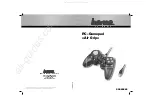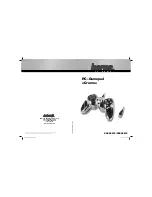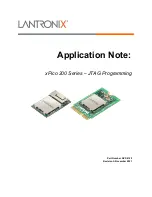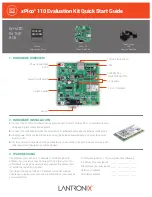
CHAPTER 10: THEORY OF OPERATION
DISTANCE ELEMENTS
L90 LINE CURRENT DIFFERENTIAL SYSTEM – INSTRUCTION MANUAL
10-21
10
The relay provides five zones of distance protection. All zones are identical in terms of settings. However, zone 1 has extra
adaptive mechanisms built-in to enhance the transient reach accuracy even when the voltage signals are supplied from
poor quality voltage sources such as capacitive voltage transformers (CVTs). Ground zones 2 through 5, in turn, have an
extra zero-sequence directional supervision implemented for their time-delayed operation after the memory expires.
Consequently, zone 1 is recommended as an underreaching element, and zones 2 through 5 are recommended as
overreaching elements and for time-delayed tripping.The relay uses offset ground directional overcurrent functions as an
optional supplement of the ground distance protection for pilot-aided schemes. The Ground Directional Overcurrent
section describes the elements.
The relay provides for an adaptive distance reach control to cope with the overreaching and sub-synchronous oscillations
when applied to, or in a near vicinity of series compensated lines. The Application on Series Compensated Lines section
has information.
The distance elements use phase angle comparators to shape their characteristics as described in the Distance
Characteristics section. The voltage and current phasors are estimated using optimized techniques as explained in the
next section.
10.3.2 Phasor estimation
The relay samples its input AC signals at 64 samples per power system cycle. A fast and accurate frequency tracking
mechanism ensures accurate filtering and phasor estimation during off-nominal frequency conditions.
The phasor estimation process for both currents and voltages is based on the commonly used Fourier algorithm. Due to a
different nature of signal distortions in the current and voltage signals digital pre-filtering algorithms have been, however,
designed and optimized separately for the current and voltage channels.
The current signals are pre-filtered using an improved digital MIMIC filter. The filter removes effectively the DC
component(s) guaranteeing transient overshoot below 2% regardless of the initial magnitude and time constant of the DC
component(s). The filter has significantly better frequency response for higher frequencies as compared with a classical
MIMIC filter. This was possible without introducing any significant phase delay thanks to the high sampling rate used by
the relay.
The voltage signals are pre-filtered using a special digital filter designed to cope with CVT transients. The patented filter
combines filtering and memory actions enabling the relay to cope with CVT noise under high Source Impedance Ratios
(SIRs). The filter controls underestimation of the fault voltage magnitude to less than 1% of the nominal and prevents
certain phase angle anomalies that can be encountered under heavy CVT noise and high SIRs.
10.3.3 Distance characteristics
10.3.3.1 Definitions
The relay shapes its distance characteristics using phase angle comparators and voltage and current phasors estimated
as described in the previous section.
The following definitions pertain to all of the distance functions:
•
I
A
, I
B
, I
C
— Phase A, B, and C current phasors
•
I
G
— Ground current from a parallel line
•
V
A
, V
B
, V
C
— Phase A to ground, phase B to ground, and phase C to ground voltage phasors
•
( )_1 — Positive-sequence phasor of ( ) derived from the phase quantities
•
( )_2 — Negative-sequence phasor of ( ) derived from the phase quantities
•
( )_0 — Zero-sequence phasor of ( ) derived from the phase quantities
•
( )M — Memorized value of ( )
•
Z — Reach impedance (
REACH
∠
RCA
)
•
Z
REV
— Reverse reach impedance for non-directional applications (
REV REACH
∠
REV REACH RCA
+ 180°)
•
Z
D
— Directional characteristic impedance (1
∠
DIR RCA
)
•
Z
R
— Right blinder characteristic impedance: Z
R
=
RGT BLD
×
sin (
RGT BLD RCA
)
×
1
∠
(
RGT BLD RCA
– 90°)
Содержание L90
Страница 14: ...1 4 L90 LINE CURRENT DIFFERENTIAL SYSTEM INSTRUCTION MANUAL FOR FURTHER ASSISTANCE CHAPTER 1 INTRODUCTION 1 ...
Страница 68: ...2 54 L90 LINE CURRENT DIFFERENTIAL SYSTEM INSTRUCTION MANUAL SPECIFICATIONS CHAPTER 2 PRODUCT DESCRIPTION 2 ...
Страница 136: ...3 68 L90 LINE CURRENT DIFFERENTIAL SYSTEM INSTRUCTION MANUAL CONNECT TO D400 GATEWAY CHAPTER 3 INSTALLATION 3 ...
Страница 224: ...4 88 L90 LINE CURRENT DIFFERENTIAL SYSTEM INSTRUCTION MANUAL FLEXLOGIC DESIGN USING ENGINEER CHAPTER 4 INTERFACES 4 ...
Страница 692: ...6 36 L90 LINE CURRENT DIFFERENTIAL SYSTEM INSTRUCTION MANUAL PRODUCT INFORMATION CHAPTER 6 ACTUAL VALUES 6 ...
Страница 708: ...7 16 L90 LINE CURRENT DIFFERENTIAL SYSTEM INSTRUCTION MANUAL TARGETS MENU CHAPTER 7 COMMANDS AND TARGETS 7 ...
Страница 742: ...9 6 L90 LINE CURRENT DIFFERENTIAL SYSTEM INSTRUCTION MANUAL TESTING CHAPTER 9 COMMISSIONING 9 ...
Страница 804: ...10 62 L90 LINE CURRENT DIFFERENTIAL SYSTEM INSTRUCTION MANUAL FAULT LOCATOR CHAPTER 10 THEORY OF OPERATION 10 ...
Страница 872: ...C 6 L90 LINE CURRENT DIFFERENTIAL SYSTEM INSTRUCTION MANUAL COMMAND LINE INTERFACE APPENDIX C COMMAND LINE INTERFACE C ...
Страница 878: ...D 6 L90 LINE CURRENT DIFFERENTIAL SYSTEM INSTRUCTION MANUAL REVISION HISTORY APPENDIX D MISCELLANEOUS D ...
Страница 882: ...iv L90 LINE CURRENT DIFFERENTIAL SYSTEM INSTRUCTION MANUAL ABBREVIATIONS ...
Страница 900: ...xviii L90 LINE CURRENT DIFFERENTIAL SYSTEM INSTRUCTION MANUAL INDEX ...
















































